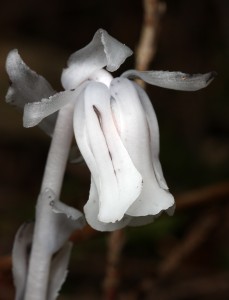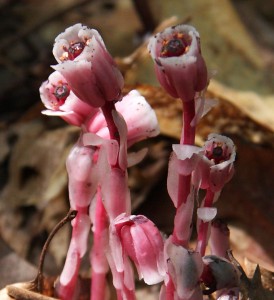The Corpse Plant
Posted in Learning Experiences on March 26 2012, by Matt Newman
 Monotropa uniflora. The scientific name isn’t particularly menacing; it suggests the singular–mono-, uni-. But on a register of local vegetation, you’d likely overlook it. It’s a passing Latin designation in a sea of other plants, many of them named after scientists. And this remains the case up until you get to know this pale, vampiric oddity of the plant kingdom.
Monotropa uniflora. The scientific name isn’t particularly menacing; it suggests the singular–mono-, uni-. But on a register of local vegetation, you’d likely overlook it. It’s a passing Latin designation in a sea of other plants, many of them named after scientists. And this remains the case up until you get to know this pale, vampiric oddity of the plant kingdom.
A friend (one altogether disinterested in botany, strangely enough) happened to post an image and a scientific name on Tumblr the other day. I was hooked from that moment. What was this “plant,” with its ghostly presentation, and what other traits were so interesting that it would distract a chemical engineering student from her studies long enough to share it? With its singular, slumped flower, it looked like a tulip under the cloud of an awful malaise; from petal to stem, there was not a single blush of color.
The common name fits: “Corpse plant,” or “Ghost plant.” It’s a member of the Ericaceae. Just a few weeks ago, I was writing about the neotropical members of this same family which grow, particolored, in the Conservatory. But how could this be at all related to the everyday blueberry, let alone its tropical variant? And yet, it is–albeit distantly. The sickly pallor of the plant is owed to the fact that it contains no chlorophyll whatsoever. By deduction, you can then guess that it doesn’t perform any kind of photosynthesis. So how does it survive?
The answer: it’s a myco-heterotroph. And I’m sure you’re scratching your head at this point.

Unlike most members of the plant kingdom, which pin their survival to the process of photosynthesis (hence chlorophyll), the corpse plant is a parasite. And not just any parasite, but one which targets fungus; it grows specifically from fungi that are mycorrhizal with trees. In layman’s terms, it feeds on mushrooms that join with the roots of trees in a symbiotic relationship. Thus the parasite uses a middle man to pull energy from those trees. Its lack of a need for sunlight also means it can grow in dark places, such as the understories of thick forests. At best it’s a thief, at worst a creep.
But the parasitic strangeness of this plant isn’t quite driven home until you see one tinted pink, or–even more rarely–a deep red approaching the color of blood. It does suck the life from other plants, after all.
Sadly, those looking to propagate or cultivate this woodland skulker may be out of luck–the complicated process by which the corpse plant survives is beyond challenging to recreate in an artificial environment. So if someday you find yourself wandering a dim forest in the eastern U.S. and happen upon this uncommon and somewhat morbid parasite, consider yourself lucky. Or, at the very least, shake off your goosebumps and move along.
Photos courtesy of Wikimedia Commons.

